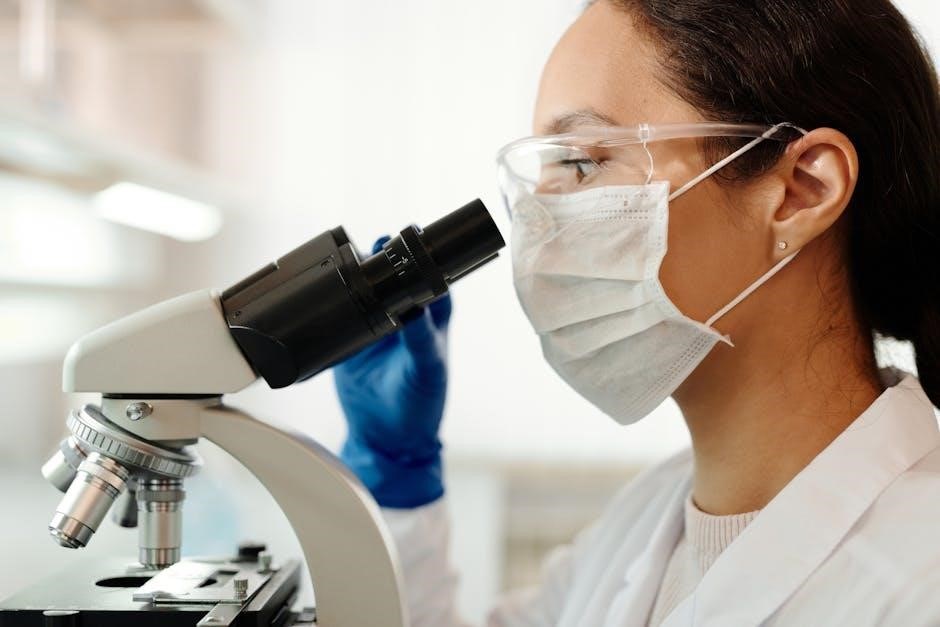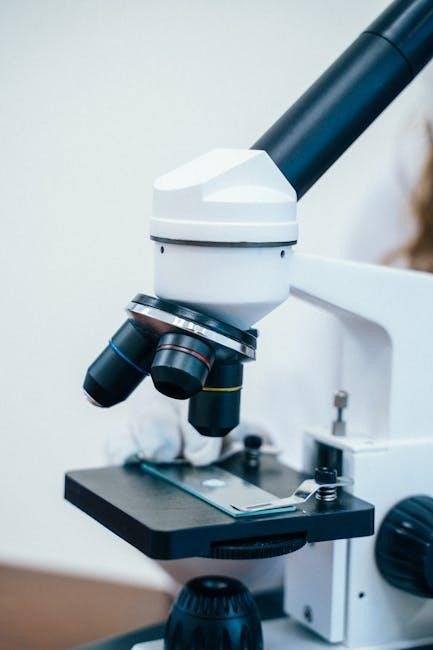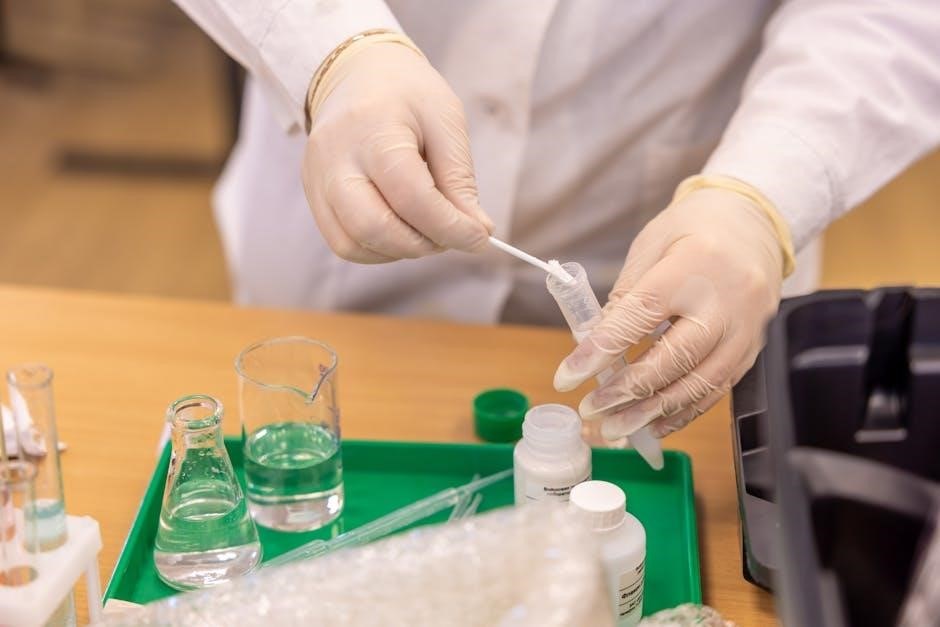
A biology lab manual serves as an essential guide for structured, hands-on learning experiences in biological sciences. It provides detailed procedures, safety protocols, and key concepts to ensure effective experimentation and skill development. By following the manual, students can conduct investigations methodically, fostering critical thinking and scientific inquiry.
Importance of Lab Manuals in Biology Education
Biology lab manuals are crucial for providing structured, organized learning experiences. They ensure consistency and accuracy in experiments, promoting reliable results. Manuals prepare students for proper lab practices, emphasizing safety and ethical standards. They also foster critical thinking and scientific literacy, enabling students to connect theoretical concepts with practical applications. By standardizing procedures, lab manuals help students develop essential skills in data collection, analysis, and scientific communication, enhancing their overall understanding of biological principles.
Structure and Content of a Typical Biology Lab Manual
A typical biology lab manual includes an introduction, list of materials, step-by-step procedures, safety precautions, and expected outcomes. It often contains background information, diagrams, and data tables to guide students. Additional sections may cover proper waste disposal, troubleshooting common issues, and references for further reading. The manual ensures experiments are conducted safely and efficiently, promoting hands-on learning and scientific inquiry while aligning with curriculum goals.
Lab Safety and Precautions
Lab safety is crucial in biology settings to prevent accidents and ensure a secure environment. It involves following specific guidelines, proper equipment handling, and emergency preparedness.
General Lab Safety Rules
- Always wear appropriate personal protective equipment (PPE), such as lab coats, gloves, and goggles, to protect against chemical or biological hazards.
- Read and follow all safety protocols and instructions provided in the lab manual or by instructors before starting experiments.
- Never eat, drink, or apply cosmetics in the lab to avoid accidental ingestion of harmful substances.
- Keep long hair tied back and avoid loose jewelry that could get caught in equipment.
- Handle sharp objects, hot instruments, and electrical equipment with extreme caution to prevent injuries.
- Ensure proper ventilation and avoid inhaling fumes from chemicals or biological specimens.
- Dispose of waste materials in designated containers and follow proper decontamination procedures.
- Immediately report spills or accidents and clean them up according to safety guidelines.
- Never leave open flames or electrical equipment unattended and keep emergency exits clear.
- Familiarize yourself with the location and use of safety equipment, such as fire extinguishers and eye wash stations.
Personal Protective Equipment (PPE)
Personal Protective Equipment (PPE) is essential for safeguarding against hazards in biology labs. Common PPE includes lab coats, gloves, goggles, and face masks, which protect skin, eyes, and respiratory systems from chemicals, biological agents, and other risks. Always inspect PPE for damage before use and follow proper donning and doffing procedures. Lab coats should be tied securely, and gloves should cover wrists to prevent exposure. Never reuse or share PPE to maintain hygiene and safety standards.
Proper Waste Disposal in Biology Labs
Proper waste disposal in biology labs is crucial to prevent contamination and environmental hazards. Biohazardous waste, such as infected materials, must be autoclaved or disposed of in designated bins. Chemical waste requires separation and neutralization before disposal. Recyclable materials should be sorted, while non-hazardous waste goes into general bins. Always follow lab-specific guidelines and use color-coded containers to ensure safe and compliant waste management.

Essential Biology Lab Equipment
Essential biology lab equipment includes microscopes, thermometers, pH meters, and centrifuges. These tools enable accurate measurements, observations, and experiments. Regular maintenance and calibration ensure optimal functionality and precision always.
Common Types of Lab Equipment
Common biology lab equipment includes microscopes, thermometers, pH meters, centrifuges, and spectrophotometers. These tools are essential for observing specimens, measuring temperatures, testing acidity, separating substances, and analyzing light absorption. Other key items are balances, autoclaves, and pipettes, which aid in precise measurements, sterilization, and liquid transfers. Each piece of equipment plays a specific role in facilitating accurate and efficient biological experiments, ensuring reliable data collection and analysis.
Calibration and Maintenance of Equipment
Calibration and maintenance of lab equipment are crucial for ensuring accuracy and longevity. Regularly check and calibrate instruments like microscopes and pH meters using standard references. Clean equipment after each use and follow manufacturer guidelines for servicing. Proper maintenance prevents malfunctions, ensures reliable data, and extends equipment lifespan. Keep records of calibration and maintenance for accountability and future reference.

Experimental Design in Biology Labs
Experimental design in biology labs involves planning and executing structured investigations to test hypotheses. It ensures controlled testing of variables and comparison between groups to validate results and support conclusions.
Identifying Variables (Independent, Dependent, Controlled)
In biology experiments, variables are factors that can change. The independent variable is manipulated by the researcher, while the dependent variable is measured as a result. Controlled variables are kept constant to ensure a fair test. Identifying these variables is crucial for designing experiments, as it allows for clear cause-and-effect relationships to be established and supports accurate data interpretation.
Formulating a Hypothesis
A hypothesis is a testable explanation for an observed phenomenon or the expected outcome of an experiment. It is typically stated in an “if-then” format, proposing a relationship between variables. A well-defined hypothesis guides the experimental design and provides a framework for data collection and analysis. It must be specific, measurable, and falsifiable to ensure the experiment can validate or reject it effectively.
Setting Up Controls and Experimental Groups
Setting up controls and experimental groups is critical for valid experimentation. The control group remains unchanged, providing a baseline for comparison, while the experimental group receives the variable being tested. This setup ensures that any observed effects can be attributed to the manipulated variable. Properly establishing these groups helps minimize confounding factors, allowing for accurate data collection and reliable conclusions to be drawn from the experiment.
Data Collection and Analysis
Data collection involves systematic note-taking and accurate measurement of observations. Analysis interprets results, often using graphs and charts to visualize trends, ensuring clear and objective conclusions are drawn.
Methods for Recording Observations
Accurate and systematic recording of observations is crucial in biology labs. Use a ruled notebook to document aim, procedure, and data. Write clearly, noting measurements, phenomena, and anomalies. Organize data in tables or graphs for clarity. Ensure all entries are dated, signed, and thorough. Review observations to confirm accuracy and completeness, as these records form the foundation for analysis and reporting in lab experiments.
Using Graphs and Charts to Present Data
Graphs and charts are essential for presenting biological data clearly and effectively. Use bar graphs for comparisons, line graphs for trends, and scatter plots for relationships. Ensure axes are labeled, titles are descriptive, and legends clarify categories. Maintain clarity and accuracy, avoiding unnecessary decorations. Organized data visualization enhances understanding and supports meaningful conclusions, making complex results accessible and interpretable for analysis and reporting in biology experiments.

Materials and Reagents
This section lists all materials and reagents required for experiments, ensuring preparedness. It details quantities, preparation methods, and proper storage to maintain accuracy and safety standards.
Listing Required Materials for Experiments
Each experiment begins with a detailed list of required materials, ensuring students are prepared. This section categorizes items, such as glassware, reagents, and equipment, specifying quantities and sources. It also notes any optional materials for enhanced experimentation. Clear organization helps students gather supplies efficiently, minimizing delays. Examples include microscopes, test tubes, and specific chemicals, ensuring accuracy and safety in procedural execution. This list is tailored to the experiment’s complexity and class size.
Preparation of Solutions and Reagents
Preparing solutions and reagents is a critical step in biological experiments. This section provides step-by-step instructions for accurately measuring, dissolving, and mixing substances. Techniques include calculating molarity, diluting stock solutions, and ensuring sterility when required. Proper labeling, storage, and disposal methods are emphasized to maintain safety and avoid contamination. Students learn to follow precise protocols to ensure reliable experimental outcomes. This skill is essential for conducting accurate and reproducible biological assays.
Step-by-Step Lab Procedures
This section outlines clear, organized instructions for conducting experiments safely and efficiently. Each procedure is designed to ensure reproducibility and optimal learning outcomes in biology labs.
Detailed Instructions for Conducting Experiments
Each experiment in the biology lab manual includes step-by-step guidance, ensuring clarity and precision. Students are instructed to prepare materials, follow safety protocols, and execute procedures systematically. Clear descriptions of expected outcomes and troubleshooting tips are provided to address common challenges. Emphasis is placed on accurate data collection and proper use of equipment, fostering a structured and efficient experimental process.
Troubleshooting Common Issues During Experiments
Biology lab manuals often include sections dedicated to identifying and resolving common experimental challenges. These guides help students address equipment malfunctions, inconsistent results, or unexpected observations. Practical solutions and alternative methods are provided to ensure experiments proceed smoothly. Troubleshooting sections foster critical thinking and problem-solving skills, enabling students to adapt and overcome issues effectively during lab work.

Results and Discussion
The results and discussion section interprets experimental data, linking observations to hypotheses. It evaluates patterns, draws logical conclusions, and discusses implications, fostering critical thinking and scientific understanding.
Interpreting Experimental Results
Interpreting experimental results involves analyzing data to determine patterns, trends, and correlations. Compare observed outcomes with expected results based on hypotheses. Identify inconsistencies and potential sources of error. Discuss the biological significance of findings, linking them to broader scientific principles. Consider alternative explanations and the implications of unexpected results. Clear interpretation is crucial for drawing meaningful conclusions and guiding future investigations.
Drawing Conclusions Based on Data
Drawing conclusions involves summarizing findings and linking them to the experiment’s purpose. Ensure conclusions are supported by data and align with the hypothesis. Highlight biological significance and broader implications. Suggest potential extensions or applications of the research. Avoid introducing new information or speculation unsupported by results. Conclusions should be clear, concise, and reflect the experiment’s outcomes accurately.
The biology lab manual effectively guides students through experiments, fostering skills and understanding. Future research can expand on these concepts, exploring new biological applications and innovations.
Summarizing Key Findings
Summarizing key findings involves concisely reporting the main results of experiments, highlighting patterns, trends, and significant observations. This step ensures clarity and focus, making complex data accessible. By linking results to the initial hypothesis, students can assess the validity of their experiments. Effective summaries also identify limitations and areas for future investigation, fostering a deeper understanding of biological concepts and their practical applications.
Suggesting Potential Extensions of the Experiment
Suggesting extensions involves proposing additional experiments or modifications to deepen understanding. This could include varying experimental conditions, testing new variables, or exploring related biological questions. Extensions encourage critical thinking and provide opportunities for further investigation, helping students refine their hypotheses or explore unanswered questions. Such suggestions also demonstrate the potential for broader applications of the experiment in advancing biological knowledge and skill development.
Lab Report Writing Guidelines
Best Practices for Scientific Writing
Clarity and conciseness are paramount in scientific writing. Use precise language, avoid jargon, and ensure objectivity. Organize ideas logically, with clear headings and subheadings. Properly cite sources to maintain academic integrity. Use passive voice appropriately, as it emphasizes the research over the researcher. Ensure data is accurately represented, and conclusions are supported by evidence; Regularly proofread to eliminate errors and improve readability.